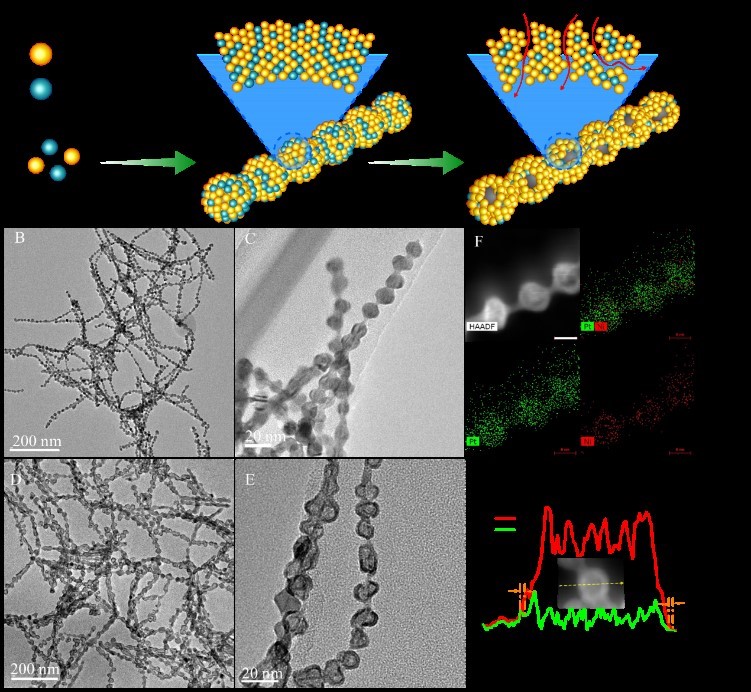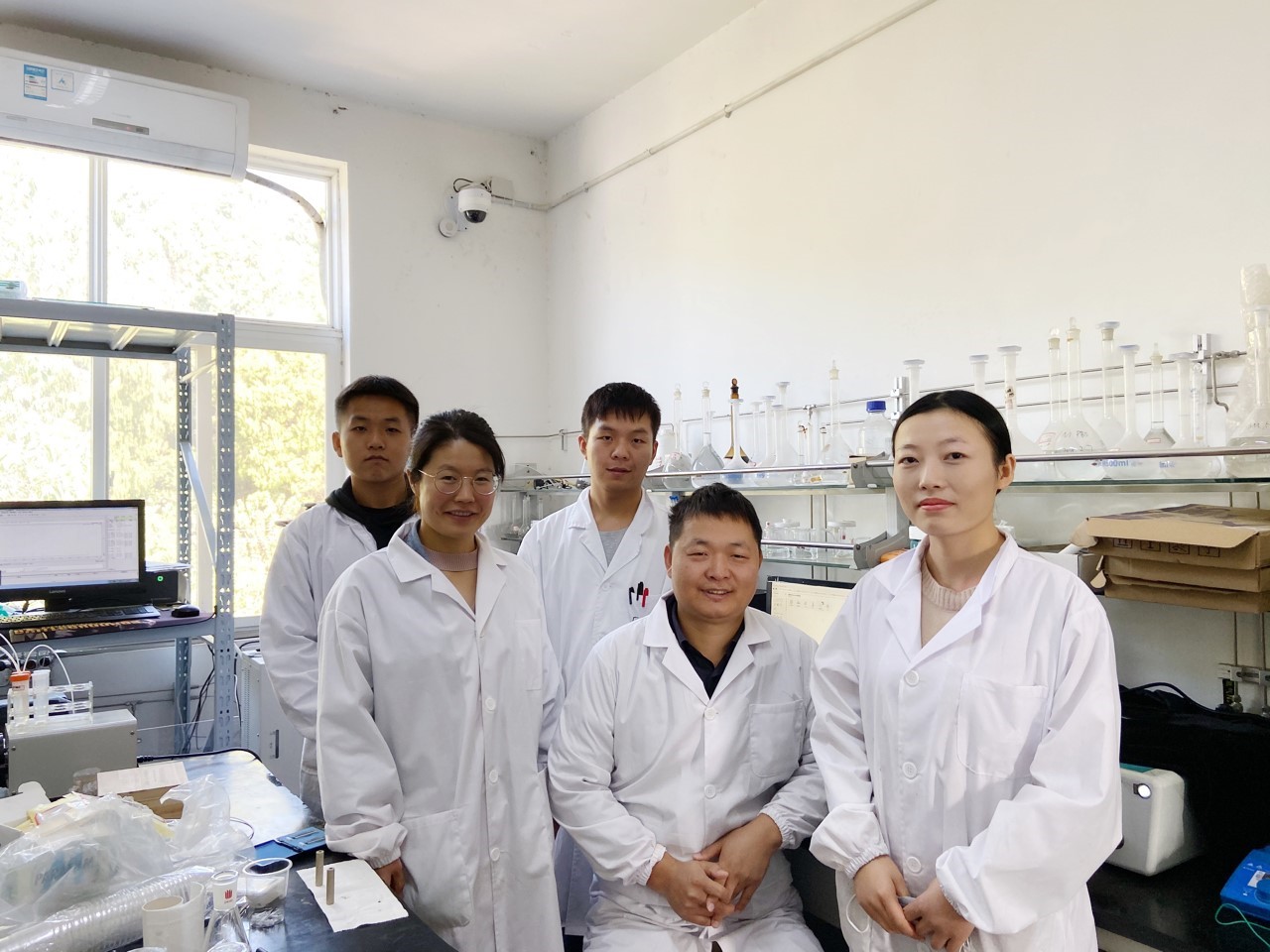On November 15, 2019, the research group led by Prof. Xia Baoyu from the School of Chemistry and Chemical Engineering of HUST published a research paper entitled "Engineering bunched Pt-Ni alloy nanocages for efficient oxygen reduction in practical fuel cells" on Science. This paper demonstrates the new research progress made by the research group led by Prof. Xia Baoyu in efficient long-life platinum alloy catalyst: Tuning the nick-surface structure and components of the platinum-based catalyst by (electrical) chemical corrosion method, thereby greatly enhances the service quality and lifespan of high-efficiency platinum nickel alloy catalysts in actual fuel cell devices, which is expected to become an effective method in developing fuel cells.
Dr. Tian Xinlong from the School of Chemistry and Chemical Engineering is the first author; Dr. Zhao Xiao from the University of Electro-Communications (Japan) and Dr. Su Yaqiong from the Eindhoven University of Technology (Netherland) are the co-authors. Huazhong University of Science and Technology is the signature unit of the first author. Prof. Xia Baoyu from the School of Chemistry and Chemical Engineering of HUST and Prof. Lou Xiongwen from Nanyang Technological University (Singapore) are the corresponding authors of the paper. It is the first time that the faculty of the School of Chemistry and Chemical Engineering of HUST publishes a paper on Science.
Development of efficient and robust electrocatalysts is critical for practical fuel cells. The research group reports one-dimensional bunched platinum-nickel (Pt-Ni) alloy nanocages with a Pt-skin structure for the oxygen reduction reaction that display high mass activity (3.52 amperes per milligram platinum) and specific activity (5.16 milliamperes per square centimeter platinum), or nearly 17 and 14 times higher as compared with a commercial platinum on carbon (Pt/C) catalyst. The catalyst exhibits high stability with negligible activity decay after 50,000 cycles. Both the experimental results and theoretical calculations reveal the existence of fewer strongly bonded platinum-oxygen (Pt-O) sites induced by the strain and ligand effects. Moreover, the fuel cell assembled by this catalyst delivers a current density of 1.5 amperes per square centimeter at 0.6 volts and can operate steadily for at least 180 hours.

Fig. 1 Structural and compositional characterizations of Pt1.5Ni-BNSs.
The research group prepared bunched Pt-Ni NCs and demonstrated that they are efficient and durable ORR electrocatalysts for fuel cells. The as-obtained bunched Pt-Ni alloy NCs showed high mass and specific activities of 3.52 A mgPt−1 and 5.16 mA cmPt−2, respectively, which are 16.8 times and 14.3 times higher than those of a commercial Pt/C catalyst. Our catalyst also exhibited robust stability with negligible activity decay even after 50,000 potential-scanning cycles. The H2-air fuel cell assembled by this Pt-Ni catalyst achieves a peak power density of 920 mW cm−2 and delivers a current density of 1.5 A cm−2 at a voltage of 0.6 V for at least 180 hours, demonstrating the great potential for practical application. In situ XAFS, theoretical calculation, and experimental results reveal that such excellent performance could be ascribed to the integration of a hollow structure and dimensional architecture in the bunched Pt-Ni alloy NCs.

Fig. 2 Electrochemical and fuel-cell performance of various Pt-based samples.
This work provides an effective strategy for the rational design of Pt alloy nanostructures and will help guide the future development of catalysts for their practical applications in energy conversion technologies and beyond. It is supported by National Natural Science Foundation of China, Huazhong University of Science and Technology and the School of Chemistry and Chemical Engineering.
Link to the paper: https://science.sciencemag.org/content/366/6467/850
Dr Xia is currently a full professor in the School of Chemistry and Chemical Engineering at Huazhong University of Science and Technology (HUST), China. He received his Ph.D. degree in Materials Science and Engineering from Shanghai Jiao Tong University (SJTU) in 2010. He worked at Nanyang Technological University (NTU) from 2011 to 2016. His research interests are in the areas of nanostructured functional materials and their application in sustainable energy and clean environment technologies including fuel cells, batteries and carbon dioxide conversion. He published over 60 peer-review papers in international journals in Chemistry and Materials Science such as Nature Energy, Nature Commun., J. Am. Chem. Soc., Angew. Chem. Int. Ed., Adv. Mater., EES etc. He was awarded by National 1000 Young Talents Program of China in 2016.
Dr. Xia’s lab’s work and goals are to design and prepare nanostructures for energy harvesting and environmental protection. They focus on nanocatalysts with electrochemical technologies for the future clean, green and sustainable energy and environments. Recently, the research group has published more than 70 papers (including 1 ESI hotspot paper and 21 ESI highly cited papers), with their research achievements cited by scholars at home and abroad for more than 8000 times. They have participated in the edition of 3 monographs and applied for 4 patents (with 3 authorized patents). Prof. Xia Baoyu was selected as one of the Highly Cited Researchers by Clarivate and the Journal of Materials Chemistry A Emerging Investigators in 2019.
The School of Chemistry and Chemical Engineering at Huazhong University of Science and Technology (HUST) has been enhancing the introduction and cultivation of high-level talents, and the leadership team has visited many cities and places to recruit researchers and talents, so as to facilitate the long-term development of the school and the discipline. At the same time, the school accurately grasps the discipline layout and development positioning, academic team scale and hierarchical structure, and introduces a large number of young talents based on Key Laboratory of Material Chemistry for Energy Conversion and Storage of Ministry of Education, Hubei Key Laboratory of Bioinorganic Chemistry and Materia Medica, and Hubei Key Laboratory of Material Chemistry and Service Failure, so as to improve the integrated competitiveness of the school.

Prof. Xia Baoyu and the research group members